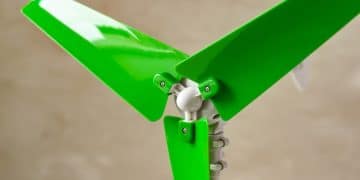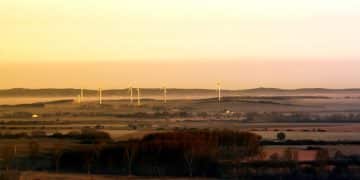Newest Methods for Recycling Rare Earth Elements from Wind Turbines
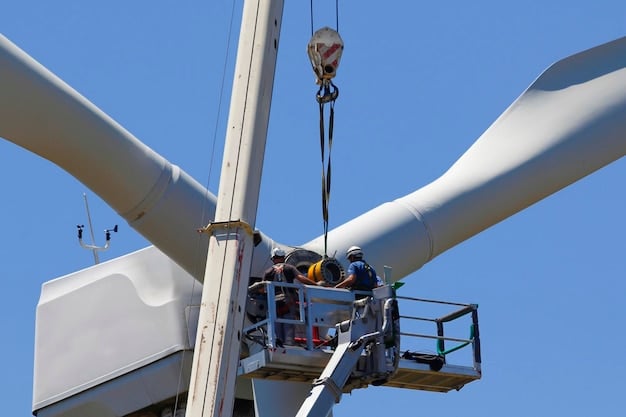
The newest methods for recycling rare earth elements from wind turbines include hydrometallurgical processes, direct recycling, and bio-leaching, all aimed at recovering valuable materials and reducing environmental impact.
As the demand for renewable energy surges, so does the need for sustainable practices in manufacturing and decommissioning wind turbines. A critical aspect of this is recycling rare earth elements from wind turbines, which are essential components in the turbine’s magnets.
Why Recycle Rare Earth Elements from Wind Turbines?
Recycling rare earth elements from wind turbines is essential for environmental sustainability and resource efficiency. These elements, vital for high-performance magnets, are in limited supply and often mined in environmentally damaging ways.
Recovering these materials from end-of-life turbines reduces the need for new mining, lowers carbon emissions, and promotes a circular economy. This approach not only conserves valuable resources but also minimizes the environmental footprint associated with the production of wind energy.
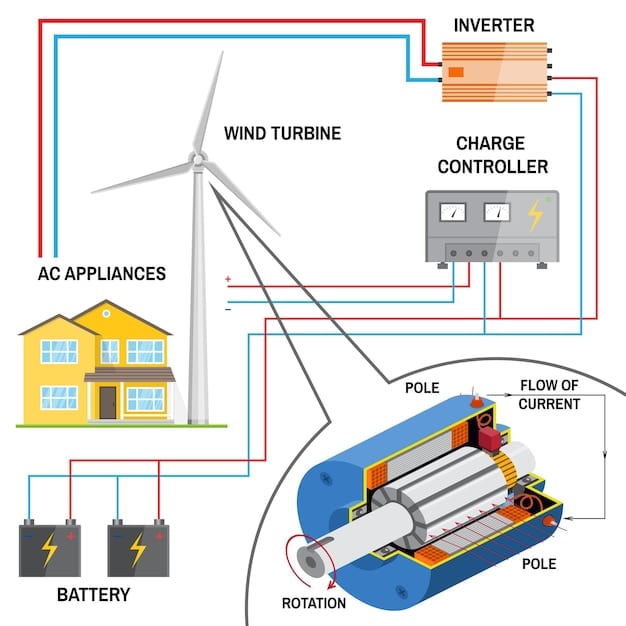
Environmental Impact of Mining Rare Earth Elements
Mining rare earth elements has significant environmental consequences. Traditional mining methods often involve extensive habitat destruction, soil erosion, and water pollution. Furthermore, the refining process can release toxic chemicals and radioactive materials, posing risks to both ecosystems and human health.
- Reduced habitat destruction
- Lower carbon footprint compared to primary mining
- Decreased water and soil pollution
Economic Benefits of Recycling
Recycling rare earth elements from wind turbines also makes economic sense. The cost of extracting these elements from virgin ore is high due to the complex separation processes involved. Recycling offers a cost-effective alternative by reusing existing materials and reducing reliance on global supply chains, making renewable energy more economically viable.
By establishing efficient recycling programs, the industry can create new job opportunities and stimulate economic growth in the green technology sector. Additionally, recovered rare earth elements can be repurposed in various high-tech applications, enhancing the value and sustainability of the renewable energy industry.
In conclusion, recycling rare earth elements from wind turbines offers a dual benefit: it mitigates the environmental impact of mining while providing economic advantages through resource recovery and job creation.
Hydrometallurgical Recycling Methods
Hydrometallurgical recycling methods involve using chemical solutions to extract rare earth elements from wind turbine components. These techniques offer high recovery rates and can process various types of materials, making them a versatile option for recycling.
The process typically involves leaching, solvent extraction, and precipitation to isolate and purify the desired elements. While hydrometallurgical methods can be energy-intensive, ongoing research focuses on reducing energy consumption and minimizing waste production.
The Leaching Process
Leaching is a crucial step in hydrometallurgical recycling. It involves dissolving the rare earth elements from the turbine magnets using acids or alkaline solutions. The choice of leaching agent depends on the composition of the magnets and the desired purity of the recovered elements.
- Optimizing leaching parameters for maximum efficiency
- Minimizing acid consumption and waste generation
- Exploring alternative leaching agents, such as organic acids
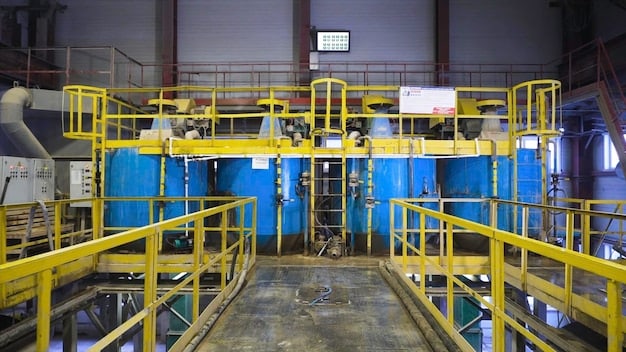
Solvent Extraction and Precipitation
After leaching, solvent extraction is used to separate and concentrate the rare earth elements. This process involves selectively transferring the elements from the leaching solution to an organic solvent, followed by stripping to recover the elements in a concentrated form.
Precipitation is then employed to selectively precipitate the individual rare earth elements. By carefully controlling the conditions, such as pH and temperature, high-purity compounds can be obtained. The resulting precipitates are then filtered, dried, and calcined to yield rare earth oxides or metals.
In summary, hydrometallurgical recycling offers a technologically advanced solution for recovering rare earth elements, with ongoing efforts to improve efficiency and reduce environmental impact.
Direct Recycling Techniques
Direct recycling techniques aim to recover rare earth elements from wind turbines without extensive chemical processing. These methods focus on mechanically separating and upgrading the magnetic materials, reducing energy consumption and waste generation.
Direct recycling offers a more environmentally friendly alternative to traditional methods by minimizing the use of hazardous chemicals and simplifying the recycling process. However, challenges remain in achieving high purity and recovery rates.
Mechanical Separation Methods
Mechanical separation involves using physical processes, such as crushing, grinding, and magnetic separation, to isolate the rare earth magnets from other turbine components. This approach is relatively simple and cost-effective, but it may not achieve the high purity levels required for some applications.
Advanced techniques, such as eddy current separation and electrostatic separation, can further improve the separation efficiency. These methods exploit differences in physical properties, such as electrical conductivity and surface charge, to selectively separate the magnetic materials.
Re-magnetization and Upgrading
After mechanical separation, the recovered magnetic materials can be re-magnetized and upgraded to improve their performance. This process involves aligning the magnetic domains and compacting the material to enhance its magnetic properties.
Re-magnetization can be achieved through various techniques, such as pulsed field magnetization and thermal treatment. Upgrading may involve adding small amounts of other elements to enhance the magnetic performance. Direct recycling offers a potentially sustainable and cost-effective way to reuse rare earth elements from wind turbines, with ongoing research focused on improving purity and performance.
In conclusion, direct recycling techniques offer a streamlined approach to reusing rare earth elements, reducing both environmental impact and energy consumption.
Bio-leaching: An Emerging Recycling Method
Bio-leaching is an innovative recycling method that uses microorganisms to extract rare earth elements from wind turbine components. This technique offers a more environmentally friendly alternative to traditional chemical processes, with the potential to reduce energy consumption and minimize waste production.
The process involves using bacteria or fungi to dissolve the rare earth elements from the turbine magnets, followed by separation and purification. While bio-leaching is still in the early stages of development, it shows promise as a sustainable recycling method.
Microbial Extraction Processes
Microbial extraction involves using microorganisms to produce organic acids or enzymes that dissolve the rare earth elements from the turbine magnets. These microorganisms can be either naturally occurring or genetically modified to enhance their extraction capabilities.
- Exploring different microbial species for enhanced extraction
- Optimizing conditions for microbial growth and activity
- Developing efficient methods for separating and purifying the extracted elements
Environmental Advantages
Bio-leaching offers several environmental advantages over traditional chemical methods. It reduces the use of hazardous chemicals, minimizes waste generation, and lowers carbon emissions. Additionally, bio-leaching can be performed at lower temperatures and pressures, reducing energy consumption.
The use of microorganisms also allows for the selective extraction of rare earth elements, reducing the need for complex separation processes. Bio-leaching holds great potential for sustainable recycling of rare earth elements from wind turbines, with ongoing research focused on improving efficiency and scalability.
In summary, bio-leaching offers a promising, eco-friendly approach to rare earth element recycling, leveraging biological processes to minimize environmental impact and energy usage.
Challenges and Future Directions
Recycling rare earth elements from wind turbines faces several challenges, including the complexity of the recycling process, the variability in turbine composition, and the lack of standardized recycling methods. Addressing these challenges is crucial for realizing the full potential of sustainable resource recovery.
Future research and development efforts must focus on improving the efficiency, scalability, and environmental performance of recycling technologies. Collaboration between industry, academia, and government is essential for driving innovation and promoting the adoption of best practices. Let’s delve into the challenges and future pathways for this burgeoning field.
Technical Challenges
One of the main challenges is the complexity of separating and purifying the rare earth elements from the turbine magnets. The magnets contain a mixture of different elements, and the separation process can be energy-intensive and costly. Developing more efficient and selective separation techniques is crucial for improving the economics of recycling.
Another technical challenge is the variability in turbine composition. Different turbine manufacturers use different magnet materials, and the composition of the magnets can vary depending on the turbine model and year of manufacture. This variability makes it difficult to develop standardized recycling methods that can be applied to all types of turbines.
Policy and Economic Considerations
Policy and economic factors also play a significant role in the adoption of recycling technologies. The lack of clear regulatory frameworks and economic incentives can hinder the development of a robust recycling industry. Governments can promote recycling by setting targets, providing subsidies, and establishing standards for recycled materials.
Additionally, the economic viability of recycling depends on the market demand for recycled rare earth elements. Creating a stable and predictable market is essential for attracting investment and ensuring the long-term sustainability of recycling programs. Overcoming these challenges will pave the way for a more sustainable and circular economy.
In conclusion, addressing the technical, policy, and economic challenges is crucial for advancing the sustainable recycling of rare earth elements from wind turbines.
The Role of Government and Industry Collaboration
Effective recycling of rare earth elements from wind turbines requires strong collaboration between government and industry. Governments can provide the necessary policy framework, funding, and incentives to support the development and deployment of recycling technologies.
Industry partners can bring their expertise in manufacturing, operations, and recycling to drive innovation and ensure the scalability of recycling programs. Collaborative efforts can accelerate the transition to a circular economy and promote sustainable resource management.
Government Initiatives
Governments can play a crucial role in promoting recycling through regulatory measures, such as setting recycling targets and mandating the use of recycled materials. They can also provide funding for research and development, as well as incentives for companies that invest in recycling technologies.
- Funding research and development to improve recycling technologies
- Creating economic incentives for companies using recycled materials
- Enforcing regulations to ensure proper recycling practices
Industry Partnerships
Industry partnerships are essential for driving innovation and ensuring the scalability of recycling programs. Collaboration between turbine manufacturers, recycling companies, and research institutions can lead to the development of more efficient and cost-effective recycling technologies.
Additionally, industry can play a role in educating consumers and promoting the benefits of recycling. Industry collaborations are crucial for advancing the circular economy and ensuring the sustainable management of rare earth elements.
Government and industry collaboration can foster innovation, ensure scalability, and promote public awareness, driving the effective adoption of rare earth element recycling from wind turbines.
| Key Point | Brief Description |
|---|---|
| ♻️ Hydrometallurgy | Uses chemical solutions to extract rare earth elements. |
| 🛠️ Direct Recycling | Mechanically separates and upgrades magnetic materials. |
| 🦠 Bio-leaching | Employs microorganisms to extract rare earth elements. |
| 🤝 Collaboration | Government and industry collaboration boosts innovation |
FAQ – Recycling Rare Earth Elements from Wind Turbines
▼
Recycling rare earth elements reduces environmental impact by lowering the need for mining, decreasing carbon emissions, and promoting a circular economy by conserving valuable resources.
▼
Hydrometallurgical recycling uses chemical solutions to extract rare earth elements, involving processes like leaching, solvent extraction, and precipitation, to isolate and purify these valuable materials.
▼
Direct recycling methods focus on mechanically separating and upgrading magnetic materials from wind turbines, which reduces energy consumption and minimizes the use of hazardous chemicals.
▼
Bio-leaching employs microorganisms to extract rare earth elements, providing an environmentally friendly alternative to chemical methods by using bacteria or fungi to dissolve these elements.
▼
Challenges include the complexity of separation, variability in component composition, and the need for standardized methods, requiring ongoing research, policy support, and industry collaboration for effective recycling programs.
Conclusion
Recycling rare earth elements from wind turbines is crucial for sustainability and resource efficiency. Emerging methods like hydrometallurgy, direct recycling, and bio-leaching offer promising ways to recover valuable materials and reduce the environmental impact. Collaboration between government and industry is essential for advancing these technologies and promoting a circular economy.


